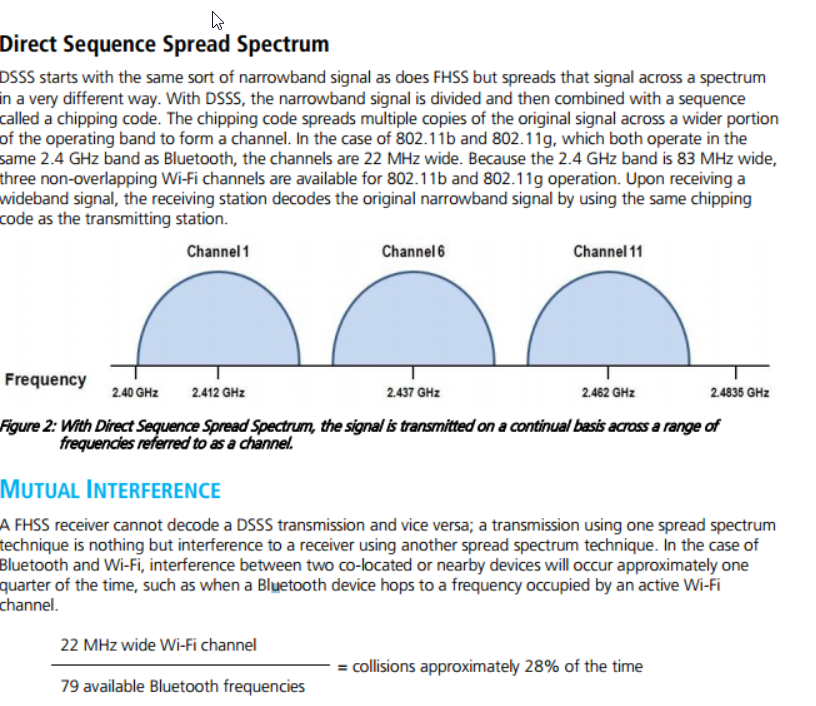I am developing a mobile peer to peer application that will probably be subjected to RF jamming, and I'm wondering if bluetooth is perhaps less susceptible to jamming than ad-hoc wifi. Bluetooth has 79 channels and wifi has 14. Also looking for any general information on the efficacy of jamming (how much jamming at what range will destroy a connection, etc) against wireless networks.
-
\$\begingroup\$ Actual jamming is illegal in most jurisdictions ... \$\endgroup\$– pjc50Commented Jul 15, 2014 at 7:55
-
\$\begingroup\$ I'd search for "frequency hopping" \$\endgroup\$– Vladimir CraveroCommented Jul 15, 2014 at 8:01
-
1\$\begingroup\$ If you seriously need a system that is properly resistant to jamming I'd suggest hiring a knowledgeable RF engineer, preferably with some experience of similar situations (EG security/military). Trying to do that sort of thing from scratch with everyday consumer gear and no prior knowledge is going to be slow, painful and likely ineffective. I don't mean to sound like I'm advertising but my employers are exactly the sort of consultants you should be speaking to, hence why I'm a little familiar with the potential answers. \$\endgroup\$– John UCommented Jul 15, 2014 at 8:53
-
\$\begingroup\$ @JohnU It appears OP is looking for software solution, not a hardware one, so RF engineer would not be of much help here. The software in mobile devices pretty much insulated from the hardware by the framework. \$\endgroup\$– MapleCommented Dec 29, 2019 at 3:34
3 Answers
Bluetooth operates in the 2.4 GHz band using 79 channels, spaced 1 MHz apart, from 2402 MHz up to 2480 MHz.
Bluetooth is less susceptible to jamming than Wi-Fi since Bluetooth uses a technology called Frequency-Hopping Spread Spectrum (FHSS). This means the signal "hops" from one channel to another, using a pseudorandom sequence known to both transmitter and receiver, 1600 times a second (every 625 µS).
In addition, Bluetooth also employs Adaptive Frequency-Hopping (AFH) which means it will only use "good" frequencies, and avoids "bad" frequencies, i.e. ones that are interfering with it.

So first of all, someone trying to jam a specific Bluetooth communication would have to be privy to its pseudorandom sequence, and then once the channel causing interference is detected, the jamming frequency would automatically avoided anyway.
Wi-Fi also operates in the 2.4 GHz band using 11 channels (in the US) spaced 5 MHz apart, from 2412 MHz to 2462 MHz. Because the bandwidth of a typical Wi-Fi signal is 20 MHz, assigning a Wi-Fi signal to a particular channel makes adjacent channels unavailable (for example, channel 6 will spill into channels 5 and 7, and a little into channels 4 and 8). So you can only get three non-interfering Wi-Fi signals in the same location: 1, 6, and 11.
Obviously, if you had a device that could jam the entire Bluetooth or Wi-Fi channels bands, such as this $5000 one, which is easier to jam is a moot point. But assuming you are trying to jam a much smaller bandwidth, since Wi-Fi uses fixed channels, it would be easier to jam Wi-Fi than Bluetooth -- since if one jammed an entire Wi-Fi channel (20 MHz), this would tie up 20 Bluetooth channels, but the AFH mechanism would allow the Bluetooth to avoid these and use channels that were not blocked.
802.11b and 802.11g WiFi operate in the same 2.4 GHz band as Bluetooth. The channels are 22 MHz wide. The 2.4 GHz band is 83 MHz wide. This means three non-overlapping Wi-fi Channels are available for 802.11b and 802.11g. interference between Wi-Fi and Bluetooth occurs only 28 percent of the time.
802.11n however offers the best way to mitigate wireless interference because it operates on the 5GHz band.
It would appear the best strategy to mitigate interference is to go with Bluetooth, unless you can support 802.11n then for sure use that. 802.11n in addition to operating in a different band offers up to 7 times the data transfer ability.
Below is a screenshot from of an excellent white paper that can be found here: http://www.digikey.com/Web%20Export/Supplier%20Content/Laird_776/PDF/laird-wireless-bluetooth-wifi-coexistence.pdf?redirected=1

Yes Bluetooth is more resistance to jamming. Not only does it frequency hop using a secret list of channels, but the bandwidth is much more narrow.
Bluetooth is 1MHz wide, whereas 802.11 Wifi is about 20MHz wide. Bluetooth can concentrate all its transmitting power in to 1MHz, whereas Wifi has it spread out over 20MHz. Wifi is usually 100mW over 20MHz, which is equivalent to 5mW over 1MHz. In the OFDM modes, only a small slice of the 20MHz transmission needs to be interferred with to cause the entire frame to be lost. Wifi can operate in 1Mbps DSSS mode where it is more tolerant to narrow band interference, but the issue of it being able to receive interference over about 20MHz compared to just 1MHz with Bluetooth still exists.
If you go with class 3 100mW Bluetooth, the device you're making will be very much like a jammer itself to any wide band signals like Wifi. Narrow band fixed frequency 2.4GHz devices like baby monitors will receive interference pulses from your device, causing a periodic popping or garbled sound in the audio.
